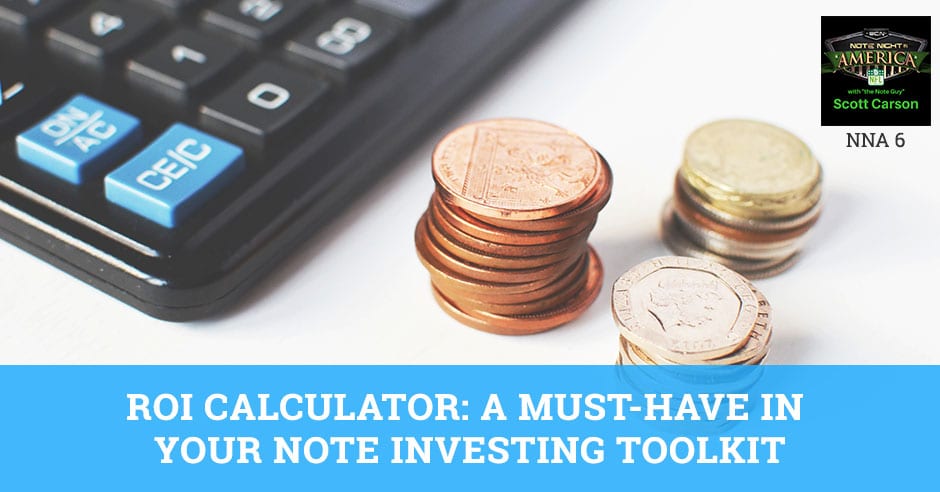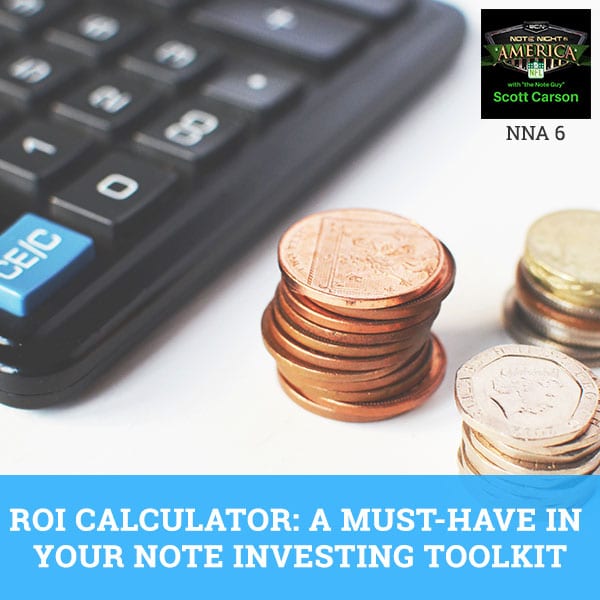
The most important tool any note investor should have is an ROI calculator. With notes, ROI calculators come with a set of rules so that you don’t kill every deal when you over-analyze everything. They differ for rentals, fix and flips and owner financing. One of the biggest and simplest rules is to pick two or three states when you’re just starting because you will have more problems than you can deal with if you spread yourself out too thin. The less variables you throw in for now, the better so you can put your focus on them.
Listen to the podcast here:
This episode is designed to help you build your ROI calculator. Many investors are running and buying deals or making offers like a gunslinger without having any knowledge or any type of calculation or ROI calculator to help them when determining if their offers are close or they are over paying, or maybe even under paying in some situations. In this episode, I go through the things to add, things you need to look for, things you also need to consider when looking at markets, and figuring your holding costs and your exit strategies and exit costs as well to see if the deal will be profitable as a note deal or an REO deal or a reinstatement that you sell off for cash for keys, deed in lieu aspects.
If you aren’t using some ROI calculator in your business, you are playing with a house of cards. You have to realize that you are running around with a revolver playing Russian roulette with a full cylinder, six bolts, and ready to pull the trigger if you’re doing something stupid. We had over close to 400 registrants for this. We do these webinars every Monday night unless if it’s a holiday or I’m traveling. The replays are available on iTunes under our Note Closers Show podcast. We do have them up on WeCloseNotes.TV.

ROI Calculator: If you aren’t using an ROI calculator in your business, you are playing with a house of cards.
We’re stoked about this episode’s content and building your ROI calculator. I am not going to create an ROI calculator. I will walk you through it and give you the things to consider. One of the big caveats is you have to create this yourself. Your ROI calculator is one of the most important things you have to have. Everybody is unique. Me giving you mine will not work. That’s the first thing you have to realize. You have to create something that works well for you. If you are used to this number and this is what you’ve been using in your business, 70% of ARV minus repairs, you are in the wrong spot.
If you are using this in your number, and we get a lot of people coming from the fix and flip side, the rehab side, or all using 70% of ARV, you are wrong, because the note business is totally different than fix and flip business. You have to think like a bank. For many years, when I was a fix and flipper, I use this rough estimate as my rough ROI guide. That’s the wrong way to do it. We don’t live in the world of ARV. We don’t live in that fantasy world. We live in what is fair market value. If you’re paying 70% of fair market value, you better be buying in California or Texas or that note deal better be on the verge of going to foreclosure tomorrow. For the most part, if you’re using this, you’re going to be in a world of hurt very soon, if not already. I see people that are paying 70 % for notes. Work harder.
There are also some rules to live by when it comes to creating your ROI calculator with notes. Your ROI calculator can kill every deal if you go crazy with it. You will overestimate everything. They send me their breakdown, and I’m like, “What’s your offering?” “I don’t have an offering yet.” I’m like, “Why are you figuring these numbers when you’re worrying about everything else? We can’t go into step B yet. You go all the way to Z and you’re not even past B or C yet.”
Let’s work through these things as your calculations will change a bit. Also, you can’t sit here and overestimate for every worst possible thing in the world. You’ve got to realize that there is some structure to the fuzzy math of notes. The structure and the fuzziness is all about sticking to your bread and butter deals. When I see people that are buying all over the place that haven’t bought there before, when they’re buying low value and high value and they’re doing all this other crazy stuff, that is a recipe for this disaster.
You have to stick to your bread and butter deals. The bread and butter deals can be for a variety reasons. You want to stick in specific areas or cities, not rural. If you do it in those areas, you have specific vendors that you’re using all the time, the asset class, and specific repairs that you have to know which stays on market. If it’s occupied, you have a whole different set of rules than when it’s vacant. Specific states have different foreclosure timeframes. You also have different taxes. Taxes are different here than they are in Wisconsin.
There’s a whole variety of things that can go wrong if you’re all across the board. This is why one of the biggest rules that I tell people all the time is pick two or three states and stick to that to begin with. If you’re buying in Ohio, Indiana, Michigan, Illinois, you will find enough deals in those areas. Missouri’s not bad. Florida’s not as much as it used to be, but if you’re buying in the big ten or southeast conference parts of the United States, you often see enough of those. Just pick a couple states, pick two states. Don’t worry about going and trying to learn every other state. If I tell you where the deals are, go there. Pennsylvania, Maryland. Go focus where you’re at.
The more diverse your area, the more problems you will have because you’re spread out. You have different vendors you’re working with, different prices, different timing, different weather, and more problems for you to deal with. This will help you in your ROI calculator. The less variables you throw into an equation, the better. The less unknowns you throw into your chemical scientific deal, the better off you’ll be. If you’re trying to combine two business models into your real estate business right now, you will get killed.
I see a lot of people, they’re like, “I’m going to use notes to help me go to rentals,” or, “I’m going to take notes and then they use it to owner finance later on,” or “I’m going to take my notes to help me boost my fix and flip business.” You have to realize you have to master one before you start doing another one. The note game is totally different than your rentals and your owner financing. Stick to one game. There are some people out that do that and that’s completely fine. Let them do that if they’ve been doing it for years, but I guarantee if they talk a big game about doing one thing or another, they’re probably not doing a lot. They may have a few situations that work well.
The reason I’ve gotten to where I’ve gotten in my life, the reason Wayne Snell, Jay Tenenbaum, Adam Adams and Karen Wall and Cody Cox, Gail Greenberg, all the people that we know and love, have done well, is because they stuck to their bread and butter. They stuck to the one thing that they understand versus trying to do a variety of things. Your business model should be the note game, not the fix and flip, not the rentals, not the owner finance. That is not efficient because now you’re dividing, and a house divided will fall. You’re dividing your interest up into different things, now you’re ROI is going to be way skewed.
Always plan on at least twelve months to foreclose. I don’t care if you’re buying in Georgia, Texas, North Carolina, or Missouri. Plan at least twelve months to foreclose or more. If it’s a twelve-month state like Florida or South Carolina, planning on eighteen months, but at least twelve months to foreclose. Never count on appreciation. I know some people are like, “I’m going to count on appreciation to grow by 15%.” If you have appreciation, that’s a bonus. That’s a cherry on top, but do not figure appreciation into your ROI or your after-repair value in your ROI.
One thing to keep in mind is a lot of people will go off a quick 30-day sale price that was different than what the value of the property is. The valued of the property may be $70,000, but they’d have to sell 30 days so maybe they’ll drop it to $30,000. Keep that in mind of where things are at. If you modify and reinstate, it’s going to be at a foreclosure sale every time as far as your ROI. Trying to take something to foreclosure when you have the opportunity to modify the statement, you’re going to lose out every time.
I’m a man with experience. I’ve got the scars, the tee shirt, and the debts to talk about it. If you take your property to foreclosure and sell it, it beats keeping the property as a rental. If it gets to worst case, rentals, it’s going to beat the ROI that owner financing the property and going that route. Higher value assets, $150,000or greater, don’t modify well, because the borrowers will want a low balance. They think they’re owed something. When you look at the existing payment compared to what your payment’s going to be as far as purchase price of the note, it’s not going to make a lot of sense.
They don’t usually foreclose quickly because the homeowners have attorney friends. They drag it out. They’ll follow because they have the extra money to do that. Also, $150,000 assets don’t often usually sell as fast as the lower value stuff, especially depending on the market. If you get higher values of $200,000 plus houses, they’re not going to sell nearly as fast as lower value houses. I know our California friends are like,“$300,000 house, that would sell like crazy here in California.”We’re not talking about that though. We’re talking about where the majority of the country is.
Let’s talk about what goes into your ROI. You have return on investment deals with inflows and outflows. Your potential inflows are profits basically. We’re talking about payments, the sale of the asset. You can get a little appreciation over time. We’re not worried about that in your ROI, but you think about that something. Your timing for a deal is extremely important. Six months is a lot better than two years. If you get something done in 90 days, you’re ROI goes up by four when you analyze it, versus it taking twelve months. The outflows, this is where you’ve got to start pulling lists together.
Your outflow stuff is going to be what you pay for the property, your purchase price, your fixed and variable expenses. A lot of people forget about the administrative costs. I’m not just talking about due diligence; I’m talking about marketing. I’m talking about lot changing. I’m talking about getting utilities turned. That ties in a little bit of repairs, but then you’ll also have to look at the outflow timing as well, on the front end. Is it going to take 90 days to get the thing rehabbed and sold, or can you sell it right now for two weeks as is? Can you take a 10% discount and sell at the foreclosure auction? If you throw it in the rehabs, now you’ve got carrying costs. You’ve got money costs. Those things are going to cost you money in the long run.

ROI Calculator: Your timing for a deal is extremely important.
Let’s talk about some of the incoming cash stuff because you’ve got to figure out how much cash you’ve got coming in. It’s a variety of short-term and long-term stuff. Your short-term is skin in the game for the borrowers, if they’re going to make up any back payments. If it’s a BK loan and there’s any BK payments to the trustee. Mid-time is a loan sale. You’d take it back, and then the property is going to be more of a long-term thing. If you can get something re-performing in six months, you can start marketing that thing for sale.
If it doesn’t work out well for the borrower to reinstate, turn around and sell the loan off to somebody. Sharing the due diligence, you have done so far makes that loan valuable long-term as a property sale at the auction and foreclosure sale. If you start figuring out rentals, that’s going to be a longer term you need. If you’re going to figure out a rental, you got to figure out your numbers and your profits divided by two because, it’s over two years for the most part to be effective, which is one of the worst extra strategies in owner financing.
After you take the property back, it’s even longer, because now you’ve got to season that note for twelve months. Your ROIs are about incoming cash and then a velocity capital. How soon can you turn that money if you need to be? How soon can you flip that money? I’m not opposed if you’re buying a sea of these and you convert them to a mortgage, that’s different. That’s different than, “I’ve got a note here I got to foreclose after a while. I got to list it. Why can’t list it to sell it now? Now I got to turn around and try to owner finance it.”
That’s what I’m getting at. I’m not talking about converting your existing performing notes into owner financing. I’m taking the long-term side here. It’s all about watching that clock. How soon can you get some stuff done? How soon can you get stuff rolled into getting your cash back or get re-performing? Time is of the essence in your ROI is, too, besides just the costs. You don’t want to sit around twiddling your thumb for six months. Take action.
Let’s talk about outgoing cash. This is where a lot of people forget about things, your due diligence costs, servicing costs, foreclosure, legal fees, special servicing stuff, and administrative. By administrative, that could be your costs for your assistant to help out there. Your cost for some marketing stuff, your cost for the software you’re using. You always got to figure taxes too. Sometimes people wait until the end until they sell it, but if it’s going to tax sale, you’d better pay the taxes. Marketing, there are costs with the video. Travel costs, some people don’t even think about this. I’m not trying to scare you to over pad your cost in your ROI. Be prepared if you have to travel and to drive by the asset yourself. I could be me driving to Texas looking at an asset or me having to hop on a plane to fly to Martin County, Florida, the show up for a foreclosure sale or foreclosure trial.
There are also repairs that you’ve got to think about if you take the property back. If it’s vacant, it’s going to need some repairs. Then you have clean out costs and utility costs. Are you going to do light repairs or heavy repairs? It’s going to be about three to five grand if you’re going to have heavy repairs. Taxes and HOA fees, it’s not up-front taxes, I’m talking about taxes that run every year. HOA fees, in some cases. The management costs, if you’re going to have it managed with your general contractor or turning the rental. Commissions, you better expect to be paying 6% commissions to find a good realtor. One of the things I do when we’re selling asset, we expect we’re going to list it at 90% and we’re going to lose 10 % in closing costs and commissions. We’re going to probably be in 81% of our as-is value. There’s closing costs in there as well.
If you’re borrowing money on a flat interest rate, 10%, 12%, or 15%, you’ve got money cost, too. A lot of people forget about that. I was talking to somebody and he was getting ready to buy on a note on a property in La Grange, Texas. The house had a market value of $90,000. He was going to pick it up for $30,000. He’s all excited about this deal, and I’m like, “A couple of questions here. How much repairs does it need?” He goes, “It needs $30,000 in repairs.”I’m like, “You went from buying it at $0.33 to buying it at $0.66 on the dollar. What are the days on market? How are you financing it? With your own capital?” He goes, “No, I have a hard money lender willing to lend me money at 18% interest rate.” I was like, “What are the days on market there?”“365.” I’m like, “Have you not calculated what your money cost is going to be? You’re going to buy $60,000 roughly, times at least 18% interest rate. What’s that cost going to be for you?” He’s like, “I don’t know, what is it going to be?” $60,000 times 0.18, that’s $10,800 is the cost of hard money alone.
The guy is at the 70% range, and he’s hoping to sell it at 90 days. You have to start thinking these through and understanding if it does make sense. Why is that property listed at 90% versus 100%? You’ve got to start reeling in your numbers, not going to the best possible outcome. Let’s take it to the middle. Not the worst, but let’s take it to the middle. Start pulling in smaller numbers. You just had to take these things into consideration. Figure out $3,500 for foreclosure costs and $1,500 for servicing, provided that it’s owner-occupied and the power’s on. There’s no big utility bills or big tax bills. Why is that? My goal is to keep that owner occupant in there and trying to get a reinstatement. I’m also looking at what rent rates are. The fact that I focus on my bread and butter, it helps me also to allow these heavy back end costs.

ROI Calculator: You have to get to a point and realize the psychology of a borrower is one of the most important things.
What’s happening out there with appreciation? Are you going to have depreciation? Does the marketing increase? Does the market decrease? Are the days on market going to go from 90 days to 180?Are you going to have the crazy borrowers? They are the ones that aren’t going to do a deed alone. They’re like, “I’m going to take this house down.” Those don’t happen very often unless you get someone crazy. Unethical contractors, this is another thing, too. If you’ve never had a contractor steal from you, you haven’t done enough deals, because you will have contractors that walk off with product, or they’ll do a little bit and get paid and not show for the last 10%. Acts of God, hurricanes, blizzards, thunderstorm, flooding, you will have all sorts of the unknown happen out there. That’s why half of these is for insurance. You got to keep that in mind a little bit. That’s why your insurance is a cost on your line.
Let’s talk about the basic ROI set up. You’re going off of as-is value, not ARV.As-is value, not after-repair value. Your basic formula is going to be this. Your fair market value, which is your as-is value, minus your expenses. What you’re offering for, plus the taxes, plus the expenses, if you take fair market value minus your costs and expenses, that’s your net profit. You divide that net profit by your costs, your offering, plus the taxes, plus expenses.Net profit divided by cost should give you a rough ROI. That’s your basic formula.
What goes into that is a lot more complicated. The idea is you add your things and you have to figure out what goes into it. The only thing you can deduct is going to be off of your taxes, a percentage of what it is minus taxes. If you don’t agree with the value of the property, that’s a different story. If all your numbers are showing one thing at $40,000 and the sellers trying to sell it at $80,000, you got to see the numbers here. I wish it was just that easy because you got to figure your exit strategies into this as well.
The way I like to set things up, it’s like let’s figure a modification and reinstatement on the front end and with a note sale in twelve months. We’re selling that note off at somewhere between 80% and 85% in the backend. Then we try to figure REO sale at 90% in the next twelve months. If it doesn’t work that way out in worst case, which is usually the cue to tell us that we don’t want to be in the rental market, is figuring if we have to foreclose what happens if we rent it out? It’s a year to foreclose and a year to rent. That’s divided by two years. Oftentimes, that’s a very single digit number of type of ROI, and REO sale can be decent, 20%greater a month, it should be somewhere in the 15%, 30%, or 40% if you bought right.
Use an excel spreadsheet, calculator, or some generic stuff as far as to lump your expenses in. When you’re experienced, you get better at covering expenses. You get better at having slash funds because you budget for expenses, but don’t end up using them because you get expertise and your vendors are really good. For those who have gone through our Note Buying Blueprint before, you would have gotten a link to download our Note Buying Blueprint ROI Calculator. It’s a very generic ROI calculator. I also like the ROI calculator on Watermark Exchange. You just have to understand what you’re changing. This is why you will never find somebody to give you their ROI calculator because you don’t know what went into it.
You don’t know what’s gone into them spending time figuring out where things are at. You throw the asset in here. You put in the monthly payment, the rate, the balance of purchase, the loan cost, the property value, and it’ll calculate the cost of purchase and then roughly the yield. It also has foreclosure, re-perform investor sale or the re-perform refinance, which the refinance thing is viable for the most part. It has hard expenses in it. This is not really the hard, fast expenses aspect of things. It’s just a generic thing in there. For closing costs and sale commission, I don’t like that aspect of it, but this is generic.
I added a separate comment for expenses, your servicing costs, legal costs, repair costs, insurance costs, and admin. Let’s say we’re going to be paying legal $45 a month for twelvemonths. That means your legal bill for that $45 service fee per month for your special service costs you $540 in a year. All these number adds up down at the bottom. Whatever you do, you need to go figure out and go back here on your loan analysis and your expenses. The thing to keep in mind is of you get crazy with your ROI calculator, it’ll eliminate deals for you before we ever look at it. You have to get to a point and realize the psychology of a borrower is one of the most important things.

ROI Calculator: There are enough ROI calculators. The best way to do it is to create one and then work through some sample deals.
One of the most important things to know is the true value of the property, double checking the taxes, and then checking the title. A $60,000 property is more valuable if it’s occupied than it is vacant. If it’s vacant, you better expect to do some repairs. If it’s occupied, you may still have some do repairs in the long run, but somebody who’s living in it and keeping it in for the most part. What I do not recommend is you go like I did. I did a little quick search for sample ROI calculators out there, and they are some complicated ROI calculators. They are not simple at all. You almost need an MBA to operate one. That’s not what you want, because a confused mind says no, and it confused note investor’s mind says, “I’m not going to fund and I’m not going to do anything,” so you want something simple. Keep it simple. Take the time to work through your ROI by adding your expenses and figure that out and go from there.
That’s the beautiful thing about the note business. You don’t have to buy hundreds of thousands of dollars of assets. You buy a few assets. They can pay your bills. If you get to 20to 30 assets, you’ve got your bills paid. You’ve got things taken care of that are coming in on a regular basis. You made some big checks and done some great stuff with you. Try to keep it simple. Spend the time to go through your expenses. If you’re calculating ROI calculators, pick up the phone, call your service and say, “Give me your costs. Can you send me this price sheet?”
You call your foreclosure attorneys in the two states or three states, “What are the approved costs for you to foreclose? Are there any other costs I need to keep in mind? Give me an average of your monthly bills that you paid out your invoices to your normal foreclosures.” That’s a good starting point for you. If you don’t want to get things faster, that’s okay. If the average cost is $3,500 to foreclose, that means I should probably be willing to shell $3,000 for cash or keys if I need to.
That’s the biggest thing I can tell you what your ROI calculator, the more precise you are with where you’re buying at, from costs and recording the assignment to insurance costs and zip code. Pick up the phone, call the guys at Risk.us. Take the time to pick up the phone and work through this. You will be so much happier in the long run because you’ll have some numbers to work off of. The IRR calculated tab basically just takes the twelve months of payments and figures it that way for you.
Take your ROI calculator, the numbers, and your expenses. This IRR calculator takes from the time that you buy to the time of the in, because a couple of numbers that would be adjusted by what you type in right here. There are enough ROI calculators. The best way to do it is to create one and then work through some sample deals. The only way I got so good at what I do is working through sample deals that I either pulled from FCI or Watermark Exchange. Those are the important things to keep in mind for you.
I want you to take action and go out and figure this stuff out. I don’t want to over-complicate this thing because it isn’t over complicated. It’s not difficult. You just got to spend time on it. This is one thing you have to spend on your business. Nobody else can help you with this besides giving some guides and give you a couple of templates and then you have to go in and edit it. Go out, put your deals together. If you’d like more information, go to WeCloseNotes.Com. Check it out. Get signed up for the membership.


One Comment on “EP NNA 6 – ROI Calculator: A Must-Have In Your Note Investing Toolkit”
What is the best roi calculator You recommend?